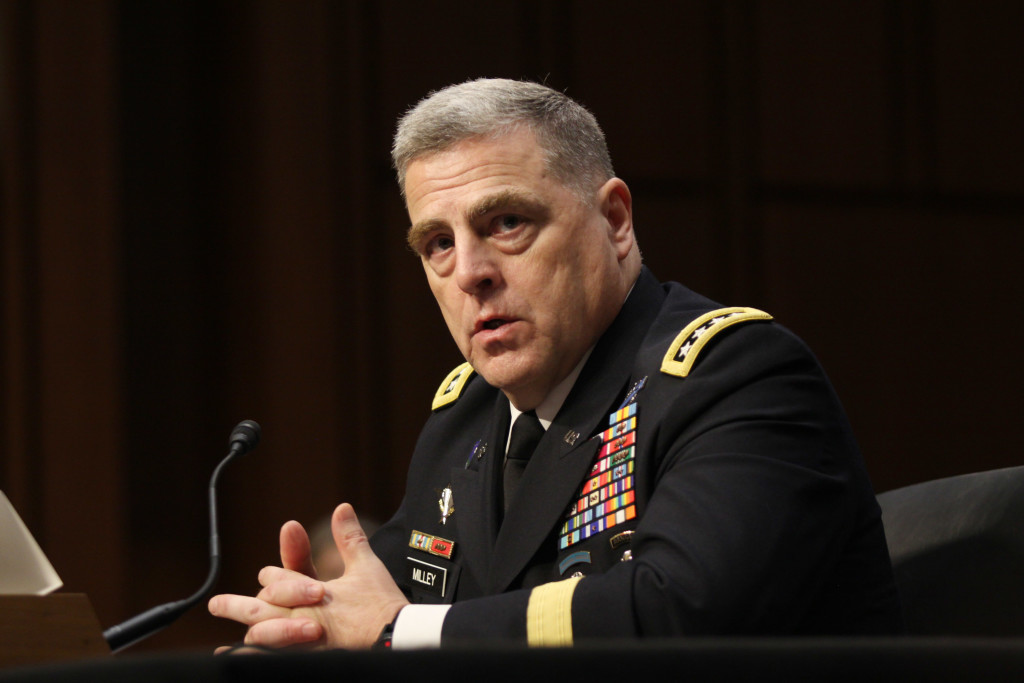Shrinking Army still capable, but at higher risk, incoming chief tells senators
Gen. Mark Milley said at his confirmation hearing to become the new Army chief of staff that his service still could meet the demand signal for Army forces, des...
Gen. Mark Milley, the nominee to be the new Army Chief of Staff, said he believes the troop-cutting plans the Army finalized this month will leave a force that’s still capable of doing all it’s being asked to — but only at a “high level” of risk, including the risk of more casualties in combat.
During his confirmation hearing Tuesday, Milley told the Senate Armed Services Committee that the Army would need to reassess its risk calculus if world events continued to put unexpected demands on Army forces, as the Ebola crisis, Russian activity in Ukraine and the rise of the Islamic State in the Middle East already have done.

But he said the ongoing drawdown has, thus far, not impinged on the Army’s ability to keep up with global combatant commanders’ demands for Army deployments. Milley currently serves as the commander of Army Forces Command and has the direct responsibility for filling those requests.
“I think from a total Army perspective, we have adequate size, but that is with significant risk,” he said. “That risk is incurred in terms of time to get to the fight, the time to mobilize [National Guard] units, time to get them trained and certified, and then it’s also significant risk in potential casualties. The second piece is not just capacity but capability to handle a high-end fight. It’s a different fight than what we have been dealing with the last decade and a half. We have got a ways to go in terms of improving our readiness with respect to the higher-end type of combat operations.”
The outgoing Army chief of staff, Gen. Ray Odierno, testified in March that only a third of the Army’s brigades were adequately trained for full-spectrum combat, partially as a result of the severe and sudden cutbacks to the readiness fund that took effect in 2013 during sequestration. The Army has begun to recover from its training deficits, but remains far from its goal of having 70 percent of its brigades trained and ready to deploy on short notice.
The reduction to an active duty force of 450,000 has been on the books for several years, but the Army announced precise force structure decisions earlier this month, including which U.S. bases would lose uniformed and civilian personnel. Milley echoed previous Army leaders’ projections that the service would need to shrink further to 420,000 active duty troops if the Budget Control Act caps in current law stay in effect because the Army would otherwise have to cut its spending on training and procurement to bare-bones levels.
But even the already-planned reduction, which involves 40,000 soldiers and 17,000 civilians, won’t be finished until 2017, and Milley said it’s difficult to forecast the demands on Army forces between now and then.
“As we continue to draw down to 450,000 by 2017, I think we are going to incur increased risk, and at the end of it, it’ll be significant risk. We’ll have to see. We don’t know what the future requirements are going to be,” he said. “If demand continues to increase as it has in the last year, I think we’ll have to reassess our risk assessment.”
Downsizing plans draw criticism in Congress
Two weeks ago, when the Army announced the blow-by-blow steps it would take in order to meet the budget-driven downsizing, the plans came under immediate fire from lawmakers, particularly those who represent bases that stand to lose thousands of soldiers and civilians, including Fort Benning, Georgia; Fort Hood, Texas; and Joint Base Elmendorf-Richardson in Alaska.
Sen. Dan Sullivan (R-Alaska), for example, blasted the Army’s decision to eliminate its only brigade-sized airborne unit in the Asia-Pacific region, saying it ran contrary to the military’s goal of “rebalancing” to the Pacific and a non-binding measure in this year’s Defense authorization bill that would urge DoD not to cut forces from that region.
“The only airborne combat brigade in the entire Asia-Pacific has now been gutted,” Sullivan said. “Of the 40,000, a huge proportion was from the Asia-Pacific region. So the idea that we’re going to be able to ‘fight tonight’ on the Korean peninsula and maintain the rebalance is all undermined. And I think our allies are going to see it as undermined.”
Although Milley was not a lead decision maker for the base-level cuts, he defended their rationale.
Related Stories
In the case of Alaska’s 4th Infantry Brigade Combat Team, he noted that the Army did not do away with the brigade entirely, but intends to gradually reduce it to a battalion-level force about a third of its original size.
“That brigade was brought down to a battalion task force with the specific intent and design that the reductions could be reversed if funding becomes available over the next couple of years,” he said. “That brigade doesn’t turn into a battalion until late (fiscal) 2016 or 2017. So it’s designed with the intent that the Army can reverse it as soon as funding is made available.”
The Army made similar decisions in Georgia and Hawaii, attempting to preserve options for rapid regrowth of large units if its budget fortunes suddenly improve. There too, brigades are being converted to battalion task forces, a formation that’s usually intended as a temporary measure.
But those brigade-level reductions only represent a small piece of the overall downsizing plan the Army announced this month. The cuts will impact nearly every base in the continental U.S. at some level, and Milley said it would take the Army some time to rebuild the active duty end strength it is planning to cut if a sudden change in world events made that necessary.
“To build a brigade, which is 3,500 to 4,000 soldiers, depending on the type of brigade you have, takes some time if you’re going to do it from scratch,” he said. “It’s about a three or four year period to really get them certified and ready to engage in ground combat operations. If you wanted to regenerate this force from 450,000 to 550,000, it can be done, but it’s not gonna be done in a very short amount of time.”
Copyright © 2024 Federal News Network. All rights reserved. This website is not intended for users located within the European Economic Area.
Jared Serbu is deputy editor of Federal News Network and reports on the Defense Department’s contracting, legislative, workforce and IT issues.
Follow @jserbuWFED




